Really Nutty 9-11 Physics
Steven Dutch, Natural and Applied Sciences, Universityof Wisconsin - Green Bay
First-time Visitors: Please visit Site Map and Disclaimer. Use"Back" to return here.
So in response to Nutty 9-11 Physics, I got some righteously indignant e-mails telling me to check outhttp://janedoe0911.tripod.com/StarWarsBeam5.html for really compelling evidence. I wasn't expecting good science, but I was completely unprepared for the total lack of everyday, common sense knowledge on the site.
Below are some sample pictures and captions, with my commentaries in blue.
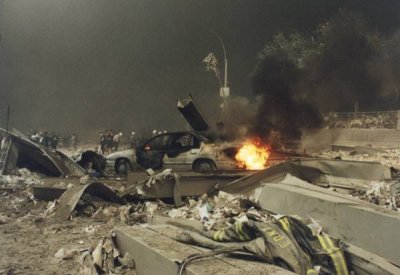 | Figure 66(g). This fire seems to be very selective. Yes. It's only burning combustibles. It's burned the interior and is finishing off the gas tank. Is there something else in the picture that should be burning? |
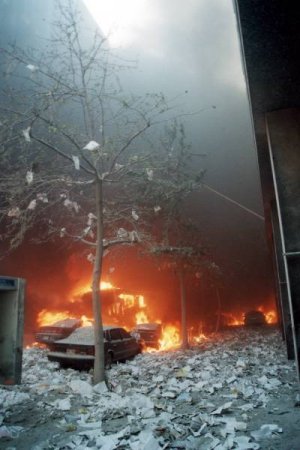 | Figure 66(o). Why doesn't the paper burn?
So how did the car catch on fire, but not the paper? The cars were set on fire first, probably by jet fuel from the plane crashes. The paper fell when the towers collapsed (you can see falling paper in many videos, and the paper in the tree branches is pretty informative). Oh, by the way, all that paper pretty much demolishes the idea that passports and other personal effects couldn't have survived. |
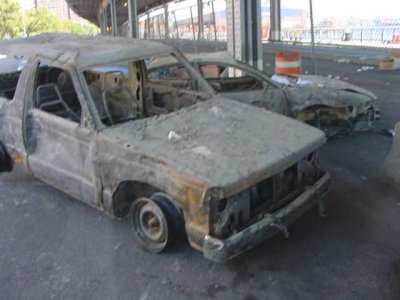 | Figure 66(f). While the bodies of these toasted vehicles still exist, they've been incinerated. All of the softer materials inside and out have disappeared. Fire will do that to cars. |
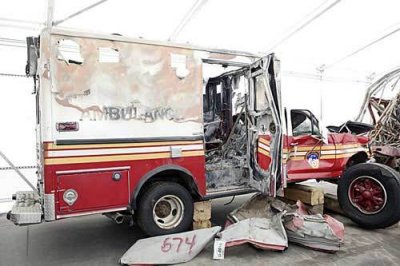 | Figure 74. Why does this ambulance have melted inside doors? The inside looks to have suffered more heat damage than the outside. What would cause that? The doors are not melted inside. The inside door panels on vehicles are fiberboard or plastic. There's more heat damage inside because there was a fire inside. Judging from the damage pattern it looks like burning debris punched through the roof. |
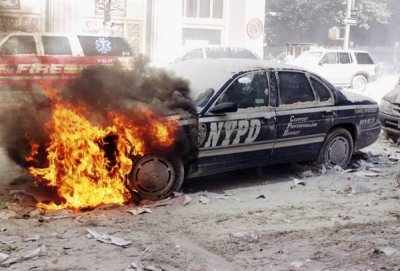 | Figure 66(h). Is there something attractive about engine blocks? Why not gasoline fuel tanks? Well, yes, there is. There's grease, oil and gasoline, and once the fire gets going, rubber hoses and tires. If the fire gets to the gas tank, the tank will go. If it doesn't, it won't. But engine fires are pretty common in cars and they don't always involve the gas tank. |
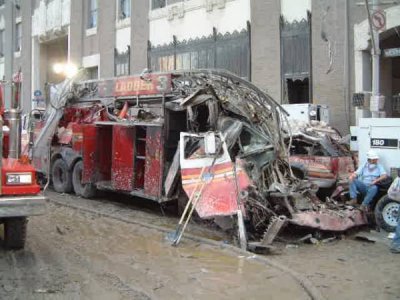 | Figure 66(e). Why would the front of this fire truck wilt? It didn't wilt, it was crushed by debris. |
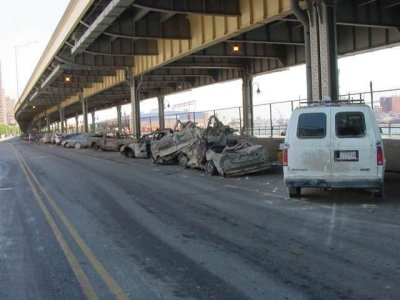 | Figure 66(a). Cars along FDR drive were randomly toasted. These cars are at least 1/2 mile away from the WTC. Note the waviness of the tire tracks. What happened? When you tow damaged (totaled) vehicles, they won't track all that accurately. |
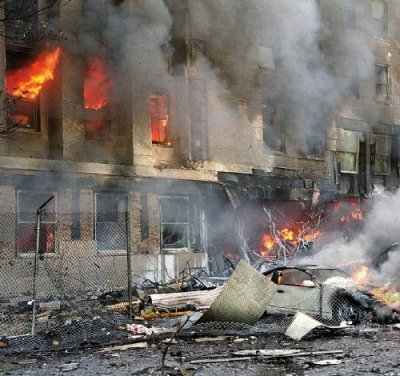 | Figure 75. Oddly enough, there were also toasted cars at the Pentagon on 9/11. I was all set to dismiss the conspiracy theories, but this indisputable evidence of a burning car outside a burning building really makes me ponder. How did that ever happen... |
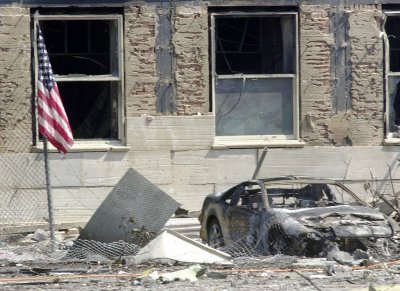 | Figure 76. This is the same vehicle shown in the previous figure after the fires were extinguished. Why is the passenger door burned? Note how the hood is curled up. Maybe the passenger side door is burned because the car was in a fire? Just speculating. |
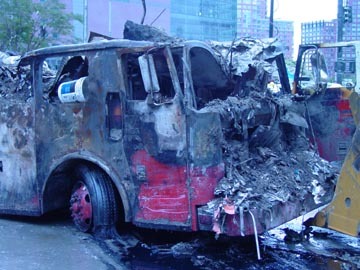 | Figure firetruck. A badly damaged firetruck. Where did its engine go? The bottom of the tire has turned to goo below a distinct horizontal line in the tire. The engine is where it always was, mostly under the crew compartment. Didn't you ever wonder what that big hump in the front of your school bus was? |
In the debate over toasted cars ignited by this article, some have argued that the wrecked vehicles on FDR drive were damaged at the WTC and were loaded up and transported and dumped on FDR drive for storage. First, there is no evidence that this was done. Second, it makes no sense to load up wrecks, transport them, only to dump them in a busy thoroughfare for storage.
After 9-11, FDR Drive and the West Side Highway near the World Trade Center weren't busy. They were closed.
These wrecks would have had to be picked up yet again and transported again.
And meanwhile the owners (or their families) would have to file insurance claims and verify that the cars were destroyed. The cars had to be moved temporarily, and many ultimately did end up in the landfill on Staten Island.
If vehicles were truly moved from the WTC to FDR Drive, we wonder why WTC steel beams were not stacked up on FDR drive, as well, if it was such a good storage area.
Because all the steel that was supposedly not being secured and examined was being taken to Staten Island where it could be secured and examined.
Third, governments may be stupid, but we doubt they could be this inefficient. If reported, it would have been a minor scandal.
It's hard to comment on this sentence because it's completely unintelligible.
Fourth, we might be wrong about the facts here, but it looks like the motive for this speculation about shifting wrecks around lower Manhattan is to protect the official story or thermite story or other pet theories. We fail to see any other explanation for such a "forced" interpretation for these photographs. Fifth, marks on the roadway suggest that some of these vehicles were pushed to the side of the roadway until they could be removed. For example, see this figure. This is a more natural explanation for why some of the cars appear to have been moved from where they were damaged rather than all the way from the WTC.
This isn't a whole lot more intelligible than the previous sentence. I gather the writer thinks the cars were destroyed in place by some exotic weapon. Of course, why wasn't the pavement melted and the center line down the street burned?
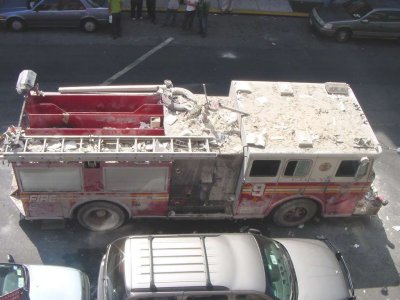 | Figure 66(t). What blew out the windows without damaging the rest of the fire truck? Judging from the stuff covering the top, my hunch would be flying debris. |
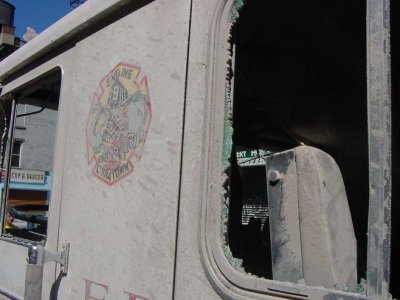 | Figure 66(v). It didn't blow out just the middle portion of the windows; it blew out the windows all the way back to the frame where it was mounted. When auto glass shatters, it breaks into centimeter size pieces. It doesn't take much to knock it all out. |
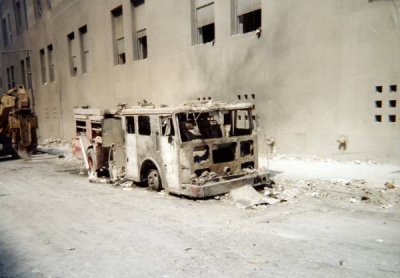 | Figure 66(z). Why is this fire truck burnt? It is missing its front grill, headlights, and related front end brightwork. Where are the tires? This is just ivory tower theorizing, but my guess is it was in a fire. Grills are made to be pretty, not sturdy, and the metal they're made of melts easily. And these days a lot of brightwork is plastic. |
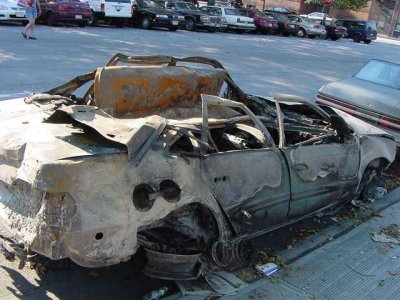 | Figure 71. What happened to the axles, wheels, and tires? On the doors, it appears that a heavy layer of paint peeled down from the top, yet the paint on the lower part of the doors has not been peeled away. Wow did the wheel get under the rear suspension? The big chunk of debris that is still on the roof collapsed the roof and broke the rear axle. That's how the wheel got under the suspension. The paint on the doors peeled off because fire will do that to auto paint. |
Work With Me, People
I'm supposed to be the ivory tower egghead. You're supposed to be the people with practical knowledge here. I don't expect people necessarily to know rocket science, but you should at least be aware of what ordinary fire and mechanical damage to vehicles looks like. You should know what happens when windows shatter on vehicles. Hint: leave something valuable on the seat sometime for a quick tutorial. My own education cost me $80 for a Discman and twice that to get the window fixed.
If you're going to lecture me on advanced and exotic weapons, at least know where the engine is in a fire truck, know that the inner panels of auto doors are not made of metal, and know a little bit about fire and how it spreads, or doesn't. Talk to some people who've experienced fires to find out how capricious it can be.
Nutty 9-11 Physics
Vaporizing the World Trade Center
Nanoparticles at the World Trade Center
Return to Pseudoscience Index
Return to Professor Dutch's Home Page
Created 30 January, 2006; Last Update 24 May, 2020
Not an official UW Green Bay site